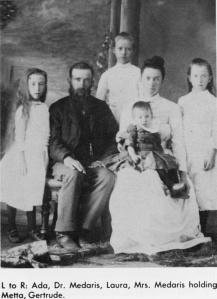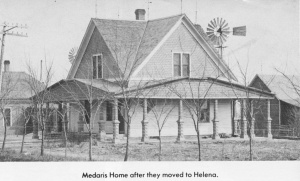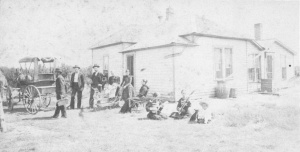He farmed outside Catarack, Indiana. Then because of poor health he moved into Catarack and sold the farm. With the money from the farm they built a store in Catarack.
A Dr. Jones had an office in the store building and he got James interested in the field of medicine. Dr. Jones' medical books were avidly read by James Medaris.
In 1885 James developed a cough and Samilda contacted malaria and chills. They moved to Bross Kansas, where he practiced medicine. They crossed the Mississippi on daughter Ada's 5th birthday.
Two years later they moved to Nashville, Kansas. In 1887, Kansas passed legislation requiring medical school for doctors. James moved to Kansas City to attend Medical School, along with his wife and four children. Harper, Kansas became their residence in 1889.
In 1893 the Cherokee Strip opened and Dr. Maderis made the run. He made a claim in Enid on the lot that presently has the Mayer shoe store. In order to be near relatives, they moved to a claim 4 miles south and 3 miles east of Helena.
-------------------------
James Henderson Medaris and Samilda Dorcas Davis were born near Spencer Ind. and grew up together, attending the same rural schools. They were married May 20, 1875. James had a store in Cataract, Indiana. Dr. Jones, who had his office in the store, interested James into becoming a Doctor. James studied Dr. Jones' medical books and practiced under his direction. Samilda was frail and especially plagued by chills and ague. Two children were born and died in Indiana.
He teamed up with Mr. John Oakley in Sept. 1885, renting a box car to ship their household goods to Kingman. He opened up a store of general merchandise at nearby Bross, Kansas. They had three daughters, Laura nine, Gertrude seven, and Ada five. Rumors began sifting into the community about the possibility of opening up some land in Oklahoma for homesteading. A fourth daughter was born named Metta.
In 1887 a law was passed requiring doctors to have two years schooling. James sold out and took his family to Kansas City and entered medical school. They then moved to Harper, Kansas where he soon had a good medical practice. A baby brother, James Vernon, was added to the family.
By 1893 Congress opened the Cherokee Strip for settlement. James took the train at Caldwell and rode it to the site of Enid. People crowded into those trains until not another one could get inside, then they climbed onto the roof and also the cow catchers, in between the coaches and just hanging on. When the train slowed to a stop, the rush was so great by those getting off that there were many injuries. Dr. Medaris took care of a broken leg and numerous other injuries in Enid before going to the townsite and staking a business and residence lot. In a few hours a tented city sprang up. His wife's brother, Will Davis, had staked a claim on 160 acres thirty miles NW of Enid. Dr. Medaris relinquished his lots in Enid and filed on land next to Will Davis, half way between Alva and Enid. In six months a four room house was built.
House furniture must be discarded down to bare essentials; however, they managed to take the organ. Dishes were packed in barrels of flour and cornmeal and eggs packed in oatscook stove, one heater, tools needed for gardening and farming, all kinds of seeds for the garden and livestock feed and spaces filled with packages of dried fruit and canned foods. Several families made up this caravan, taking all their livestock, and belongings. The one great fear was the realization that we had to ford the Salt Fork. Each evening blood curdling tales were told as to how entire wagons had disappeared in the quicksand. There were no roads across this part of Oklahoma, but the men in charge assured us they hoped to find a smooth bank when we reached the river, and they did. We made it across safely and what a joy to have that behind us.
We arrived at our new home the fifth day. There were two projects of great importance to start quickly -- digging a well and a cyclone cave. It did not take long to make a safe cave, to hide from cyclones and to store food. A man's place was sort of rated by the kind of water he found there. Next came the time for making a garden. After the land was cleared and plowed, we would raise up a piece of sod and drop a few seeds underneath, for watermelons, musk melons, pumpkins, squash and cucumbers, working the sod better for smaller seeds. We planted castor beans for shade near the chicken pen. The results of our first garden were amazing.
The second summer men from the area went to Kansas to work in harvest and returned with their wagons loaded with fruit, mostly peaches, that we canned and made into butter, and dried.
The desire now was to build a house of worship. Men volunteered their time to do the work and Ralph Gano contributed a portion of his land for a building site and cemetery. Father was able to provide money for lumber as his share. Thus the Church of Christ and Good Hope Cemetery were established. Grandmother Davis was the second person buried there.
The winters were hard on my father. The first years he had only a cart drawn by one pony, a fur cap and coat, and a buffalo robe. He would scarcely get in from one trip, when someone would be pounding on the door. Frequently an injured body would be brought to our place in a wagon, hoping to save time in getting help. Once a man brought his wife who had been bitten on the leg by a rattler. She was sitting on a chair with her leg in a churn filled with mud. The leg was badly swollen, the poison had spread as they had come 10 miles, galloping the horses all the way. She recovered.
If an injury was such that a patient should be kept quiet, that patient remained at our house until able to travel, be it two days or two months. If some member of their family could remain to care for them, they did so. My mother never knew how many would be around the table at meal time nor how many she would need to provide beds for. We were soon able to hire a girl for kitchen work and a hired man who cared for the stock and farm.
Mr. Pennock lived two miles from us. He built a dugout shelter for his stock, in the spring the stable was cleaned out, men made benches and a blackboard, and our first school was in session, taught by Mr. Pennock's daughter. A school building was soon built across the road. Our teacher for several years was Miss Cassie Coffield who was proving up on a claim about four miles from there. She walked this distance morning and night, teaching us many of the great principles of life besides handling all eight grades expertly. Each morning a new quotation would appear on the blackboard for us to memorize, the first one beginning with "A". "A good name is rather to be chosen than great riches of silver and gold." She proceeded throughout the entire alphabet.
People paid on their doctor bill with whatever they had in excess. We soon acquired a pasture full of Indian ponies. In fact the Medaris family had an abundance of everything except money. We actually did not know it was needed. All our needs were met and we were happy.
A little sister, Una Claire, was born in 1896, and died in 1900.
It was indeed a privilege to live at a time and in an area of such great hospitality and concern for others.
Metta Medaris Bull, "Our Alfalfa County Heritage", 1976
---------------
James Henderson Medaris family was the fifth generation to come to America. He was born in Owens County Indiana November 7th, 1851. He married Samilda Dorcas Davis, May 20, 1875.
They built a store in Catarack, Indiana and Dr. Jones had an office in the store building and this doctor got James interested in the field of medicine.
Dr. Jones' medical books were read over and over by James. In 1885 ill health caused James and Samilda to move to Bross, Kansas by train with their children, where Dr. Medaris practiced medicine.
Two years later Kansas passed legislation requiring medical school for his licensing. So Dr. Medaris and family moved to Kansas City so he could attend medical college.
In 1893 the Cherokee Strip opened and Dr. Medaris made the run. He made the claim in Enid on the lot that presently has the Mayer Shoe store. Later, to be near relatives, they moved to Helena Oklahoma.
To this union eight children were born, Laura, May, Gertrude Bell, Ada Ellen, Metta Agnes, Vernon, and Una Clare, she died when she was four years of diphtheria. Two children were deceased at birth.
The doctors were far and few between. Dr. Medaris practiced with a horse and buggy. Some days it would take all day to see one patient. He had trained his horse to take him home while he slept. Whenever the horse stopped, Dr. Medaris knew he was home. He fed his horse, ate his breakfast, and walked up to his office for another day.
Dr. Medaris bought the first automobile in the community. It was a white Buick, very striking in those days. People would come to see it, also wanting to take a ride in it. Dr. Medaris could see so many more patients in a day now.
There was a sad side to it, though, when horse and buggy would meet the automobile some of the horses would rare straight up and others would just run away with the buggy, hurting people. Finally when the cars were so numerous the buggies gradually disappeared.
Dr. Medaris expected people that was able to pay for his service, but if they could not it was alright, too. Many a time he would come home with a dozen eggs or a chicken, maybe a peck of potatoes. Dr. Medaris was a devout Christian man. He started the Church of Christ in Helena.
by Helen (McCall) Bachman
Residence 1870: Owen County, Indiana, with parents and younger brothers and sisters.
Residence 1880: Owen County, Indiana, with Samilda, Laura, and Gertrude
Residence 1900: Woods County, Oklahoma, with wife, 4 kids, and hired hand.
Residence 1920: Helena, Oklahoma, with Samilda


 James Henderson Medaris
James Henderson Medaris 





 - b.~ 1667 in Middlesex County, Virginia
- b.~ 1667 in Middlesex County, Virginia


 - b.21 Feb 1704 in Middlesex County, Virginia d.1799
- b.21 Feb 1704 in Middlesex County, Virginia d.1799



 - d.07 Feb 1720
- d.07 Feb 1720

 - b.~ 1759 in Dragon Swamp, Middlesex County, Virginia d.1829 in Shelby County, Ohio
- b.~ 1759 in Dragon Swamp, Middlesex County, Virginia d.1829 in Shelby County, Ohio







 - b.20 Nov 1715 in Essex County, Virginia d.1795 in Tennessee
- b.20 Nov 1715 in Essex County, Virginia d.1795 in Tennessee





 - b.13 Feb 1788 in Guilford County, North Carolina d.08 Feb 1878 in Owen County, Indiana
- b.13 Feb 1788 in Guilford County, North Carolina d.08 Feb 1878 in Owen County, Indiana

 - b.~ 1762 in Chatham County, North Carolina d.19 May 1842 in Shelby County, Ohio
- b.~ 1762 in Chatham County, North Carolina d.19 May 1842 in Shelby County, Ohio - b.23 Mar 1823 in Guilford County, North Carolina d.19 Jan 1900 in Owen County, Indiana
- b.23 Mar 1823 in Guilford County, North Carolina d.19 Jan 1900 in Owen County, Indiana
 - b.07 Jan 1790 d.10 Apr 1838 in Shelby County, Ohio
- b.07 Jan 1790 d.10 Apr 1838 in Shelby County, Ohio


 - b.1762 in Orange County, North Carolina d.27 Jul 1815 in Orange County, North Carolina
- b.1762 in Orange County, North Carolina d.27 Jul 1815 in Orange County, North Carolina
 - b.01 Feb 1794 in Orange County, North Carolina d.11 Mar 1831 in Morgan County, Indiana
- b.01 Feb 1794 in Orange County, North Carolina d.11 Mar 1831 in Morgan County, Indiana


 - b.~ 1721 in Germany
- b.~ 1721 in Germany

 - b.20 Mar 1764 d.06 Dec 1842
- b.20 Mar 1764 d.06 Dec 1842



 - b.23 May 1825 in North Carolina d.29 Jul 1879 in Owen County, Indiana
- b.23 May 1825 in North Carolina d.29 Jul 1879 in Owen County, Indiana
 - b.24 Jun 1798 in Orange County, North Carolina d.05 Aug 1899 in Owen County, Indiana
- b.24 Jun 1798 in Orange County, North Carolina d.05 Aug 1899 in Owen County, Indiana






